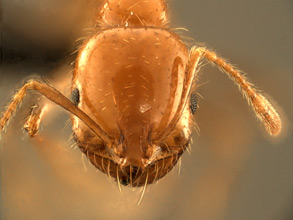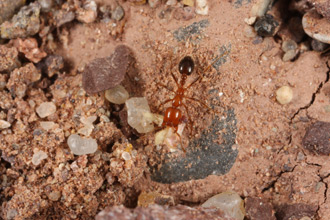- Identification
- Where this species still occurs, i.e., in the absence of the imported fire ant Solenopsis invicta, it is typically the only common, medium sized Solenopsis species. Solenopsis amblychila and Solenopsis aurea are two other native medium sized fire ants in the western US. These other species are less common and tend to be lighter colored than Solenopsis xyloni. Workers from the latter species contain some areas that are black and rarely exhibit any light brown coloration, while the former show light brown coloration without any black areas. It can be extremely difficult to differentiate Solenopsis xyloni from Solenopsis invicta (Jacobson 2006).
- Solenopsis are distinguished from other co-occurring genera by having a 10-segmented antenna with a two-segmented club at their distal end. Solenopsis xyloni workers are polymorphic and usually have darkly colored (partially or completely dark brown or black) gasters.
- Biology
- Solenopsis xyloni is part of a group of Solenopsis species that are commonly known as fire ants. Many people are already familiar with one of the two invasive members of this group, the imported fire ant (Solenopsis invicta) and Solenopsis geminata, that have spread into many tropical and sub-tropical areas of the world.
- (from Mackay and Mackay, 2002): Solenopsis xyloni nests in open areas in soil or under stones, it may build unsightly nests of loose soil on lawns. Reproductives are found in the nest throughout the year, nuptial flights occur from May through September. Flights occur in the afternoon and are usually announced by large numbers of very aggressive ants milling around the nest entrance. These ants are aggressive with a painful sting, although not nearly as aggressive as the introduced red fire ant, S. invicta. The common name "native fire ant" is derived from their painful sting.
- additional biology notes...
- Distribution
- Range
- United States and Mexico. As reported in Trager (1991) - Solenopsis xyloni is found across the southern United States from the Carolinas and Georgia, through lowland Tennessee, south central Kansas and southern Nevada to the Pacific coast of California. In Mexico, it seems to be limited to dry subtropical areas. In the southeastern U.S., Solenopsis xyloni has been largely eliminated from areas within the current range of the imported fire ant species,Solenopsis invicta and Solenopsis richteri. There is no evidence that Solenopsis xyloni ever inhabited any portion of Florida, and it is very rare or absent right along the Gulf Coast.
- Navajo Reservation Records
- Samples being processed.
- Additional Notes
- Foreshadowing what will likely become a common refrain for many organisms, we are unlikely to ever know what the biology and natural history of this species was like throughout much of its once native range. It has been eliminated by the native fire ant in what may have been its more favored habitats - mesic areas throughout much of southern North America (Ramirez et al. 2004). Presently Solenopsis xyloni is common in more arid areas of the southwest.
- Solenopsis xyloni are aggressive and will readily sting humans. This behavior is an integral part of the competitive nature and is useful in repelling other species from food resources, foraging territories and their nest. Like other "fire ants" workers are able to recruit large numbers of nestmates to large food items.
- Trager (1991) generalized what is known about fire ant biology to say this about the diet of all fire ants: Food sources are highly varied, but protein and fats from varied invertebrate prey or vertebrate carrion, and carbohydrates from fallen fruits, floral and extrafloral nectaries predominate in the diet of most fire ants.
- Etymology


- Literature
- Jacobson, A. L., D. C. Thompson, L. Murray, and S. F. Hanson. 2006. Establishing guidelines to improve identification of Fire Ants Solenopsis xyloni and Solenopsis invicta. Journal of Economic Entomolology. 99:313-322.
- Mackay, W. P. and E. Mackay. 2002. The ants of New Mexico (Hymenoptera: Formicidae). Edwin Mellen Press, Lewiston, NY.
- McCook, H. C. 1880. Formicariae. p. 182-189 in: Comstock, J. H. Report upon cotton insects. Washington, D.C.: Government Printing Office
- Ramirez, R. 2004. The influence of low humidity, Pseudacteon flies, and competition by Solenopsis xyloni on Solenopsis invicta. M.S. Thesis, New Mexico State University, Las Cruces, NM.
- Trager, J. C. 1991. A revision of the fire ants, Solenopsis geminata group (Hymenoptera: Formicidae: Myrmicinae). Journal of the New York Entomological Society. 99:141-198.
- A note about these publications. The literature cited here is not meant to be an exhaustive list of papers published about this species.
Page authored by David Lubertazzi and Gary Alpert




